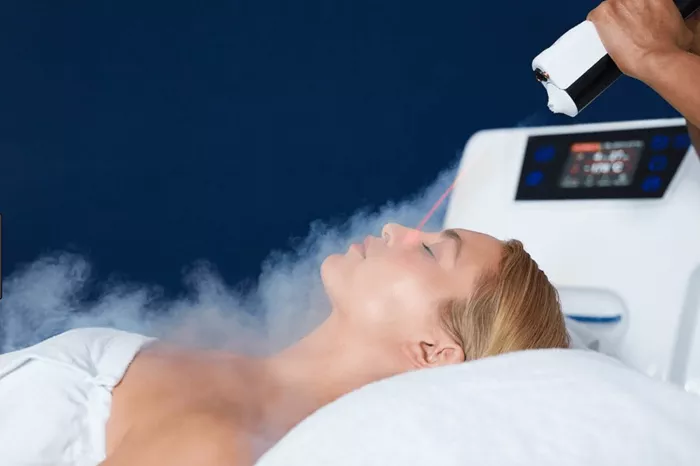Cryotherapy, a treatment method utilizing extremely cold temperatures, has garnered significant attention for its potential skin health benefits. Initially popular for athletic recovery and pain management, cryotherapy is now recognized for its dermatological applications. This treatment involves brief exposure to sub-zero temperatures, offering various health benefits. This article explores how cryotherapy can enhance skin health, focusing on its effects on acne, anti-aging, and overall skin wellness. Understanding these benefits can shed light on why this cold treatment is becoming a popular procedure in skincare regimens.
Cryotherapy and Acne: A Cold Solution to Breakouts
Acne, a common skin condition affecting millions worldwide, can be particularly challenging to treat. Traditional treatments often involve topical medications, antibiotics, or even hormonal therapy. Cryotherapy offers an innovative approach that utilizes extreme cold to reduce inflammation and kill acne-causing bacteria. When applied to acne-prone areas, cryotherapy can significantly diminish redness and swelling associated with breakouts. The cold temperatures constrict blood vessels, reducing the appearance of inflamed pimples and accelerating the healing process. Moreover, cryotherapy can decrease sebum production, an oily substance contributing to acne formation. By targeting these underlying factors, cryotherapy presents a promising alternative for those seeking relief from persistent acne without heavily relying on pharmaceuticals.
Anti-Aging Benefits: Turning Back the Clock with Cryotherapy
Aging is inevitable, but its visible signs on the skin can be mitigated through various treatments. Cryotherapy is a non-invasive method to combat signs of aging, such as wrinkles, fine lines, and sagging skin. Exposure to cold temperatures stimulates collagen production, a critical protein responsible for skin elasticity and firmness. Enhanced collagen levels help reduce the appearance of wrinkles and improve skin texture. Additionally, cryotherapy promotes better blood circulation, delivering more oxygen and nutrients to the skin. This increased circulation not only aids in rejuvenating the skin but also imparts a youthful glow. The cold treatment can also help reduce puffiness and tighten the skin, providing an overall lifted appearance. By incorporating cryotherapy into anti-aging skincare routines, individuals can experience a fresher, more youthful complexion without invasive procedures.
Overall Skin Wellness: Enhancing Health and Radiance
Beyond its targeted benefits for acne and aging, cryotherapy contributes to overall skin wellness. Regular cryotherapy sessions can improve skin tone and texture, making the skin appear more vibrant and healthy. Cold exposure helps to detoxify the skin by promoting lymphatic drainage, which aids in removing toxins and impurities. This detoxification process can prevent dullness and keep the skin clear and bright. Cryotherapy also boosts the skin’s defense mechanisms by strengthening its barrier function, which protects against environmental stressors and pollutants. Furthermore, the treatment can alleviate skin conditions such as eczema and psoriasis by reducing inflammation and soothing irritation. By enhancing the skin’s natural resilience and vitality, cryotherapy supports a holistic approach to maintaining skin health.
Targeted Treatment for Specific Skin Concerns
In addition to its broader benefits, cryotherapy can be tailored to address specific skin concerns effectively. For instance, cryotherapy facials target the delicate facial skin, providing a rejuvenating and tightening effect. The cold temperatures help to shrink pores, reducing their appearance and preventing the buildup of debris that can lead to acne. Cryotherapy facials also promote lymphatic drainage in the face, reducing puffiness and promoting a more sculpted facial contour. This targeted approach makes cryotherapy facials popular for individuals looking to refresh and revitalize their skin without invasive procedures.
Post-Inflammatory Hyperpigmentation: A Cold Solution for Dark Spots
Post-inflammatory hyperpigmentation (PIH) is a common concern for many individuals, especially those with darker skin tones. PIH refers to the dark spots or patches that develop after inflammation or injury to the skin, such as acne breakouts. Cryotherapy can effectively treat PIH by reducing inflammation and promoting faster healing of acne lesions. The cold temperatures constrict blood vessels, reducing redness and preventing the formation of dark spots. Regular cryotherapy sessions can help fade hyperpigmentation and prevent new spots from developing, leading to a more even and radiant complexion.
Combining Cryotherapy with Skincare Regimens
For optimal results, cryotherapy can be integrated into existing skincare regimens to complement other treatments and products. For example, combining cryotherapy with vitamin C serums can enhance collagen production and brighten the skin, resulting in a youthful appearance. Similarly, using moisturizers with hyaluronic acid after cryotherapy can lock in moisture and plump the skin, reducing the appearance of fine lines and wrinkles. By customizing skincare routines to include cryotherapy alongside compatible products, individuals can maximize the benefits and achieve healthier, more resilient skin over time.
Conclusion
Cryotherapy’s application in dermatology highlights its versatile benefits for enhancing skin health. From reducing acne and combating signs of aging to promoting overall skin wellness, cryotherapy offers a multifaceted approach to skincare. Its ability to harness the power of cold temperatures to stimulate natural processes within the skin makes it a compelling option for those seeking practical and non-invasive treatments. As awareness of cryotherapy’s potential grows, it will likely become an integral part of modern skincare routines, providing individuals with a refreshing way to achieve and maintain healthy, radiant skin.
Related topics:
Can Skinny People Get Buccal Fat Removal?
The Rise of Neurocosmetics: Bridging Skin Care and Emotional Well-being
Link Between Stress And Skin Problems And How Yoga Can Help


